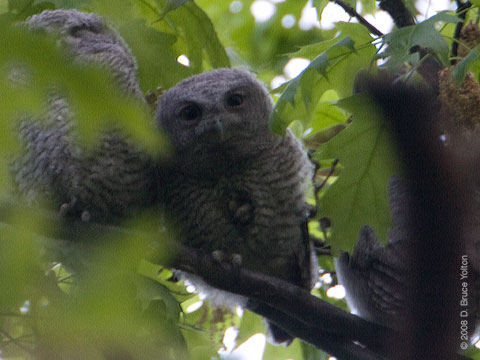Tuesday, 5-13-08
It was a nice evening. The owls were back in their regular tree and used the jungle gym of fallen trees near the stream. The fledglings spent time on the ground and by the stream bed.








It was a nice evening. The owls were back in their regular tree and used the jungle gym of fallen trees near the stream. The fledglings spent time on the ground and by the stream bed.








Owl watching is getting a lot harder. We couldn’t find them in any of the standard roost trees this evening. It took quite awhile for us to find them. Picture taking was next to impossible. While this is disappointing for me, it is a great sign that the young owls are becoming more and more independent.

It was an interesting evening. One of the fledglings had a bird with it at dusk and was busy eating it before the fly out. Then the young owls spent a great deal of time on the ground. I think the parents are starting to encourage them to hunt and forage for themselves.





















It was a relaxed night, with any of the crowds of the owl tours. Nice relaxed wake up, fly out and eventual feeding by the drive.













The owls were tougher to see than usual this evening. Things started slowly and quietly. Eventually they made their way to some streetlights and the kids were fed.
The fledglings not only can fly well they can land with ease. The little kids are growing up.

















As many of you know, I have come to enjoy watching owls, as much as I enjoy watching hawks.
As I did for the last two years, I’ve kept a blog about my adventures with Eastern Screech-Owls in Central Park this winter and spring. I’ve kept it private until now, since I didn’t want to disclose a nesting site until after the young owls fledged.
It seems people love owls too much, and they are willing to risk disturbing them by over-birding them, leading large tours to see them, photographing them too closely and using flash cameras at dusk/night.
Our small group of owl watchers carefully studied Eastern Screech-Owls this winter and spring. Between us, we ended up seeing seven Screech-Owls, three pairs and a single owl.
My 2008 owl blog details two pairs, a couple in the middle of the park, which we lost track of after just a few weeks early in the year and a pair that we followed from December until now in the North Woods. This pair ended up with three fledglings and is the same pair described in my 2007 owl blog.
I invite you to follow our progress of discovery from initial courtship and copulation, to nesting and nestlings, the fledge, and the fledglings’ initial weeks in the park.
If this blog perks your interest in seeing owls in Central Park, take the time to learn the proper etiquette for watching owls. By doing so, you’ll not only get to see an owl, but you will be able to discover a whole world of fascinating behaviors.
The rules we followed might be good for you to follow as well:
(The Eastern Screech-Owls were reintroduced to the park in 1998 and 2001-2002. One of the former park employees who helped develop and implement the project used our enjoyment of these owls as a sign the project was a success.
The project has not created a genetically diverse population of Eastern Screech-Owls in the park. It has stocked the park with owls, like stocking a pond with trout. After ten years, there is no proof of any third generation owls and there have not been any known exchanges of owls with nearby populations to diversify the Central Park population. Unless these two things happen, in my opinion, the project is a failure.)